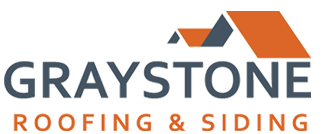Having problems with your roof?
Graystone Roofing and Siding offers free roof inspections. We will thoroughly evaluate your roof and give your our expert roofing opinion. The more you know, the better able you will be to make a decision for roof repair or roof replacement.
Inspecting your Own Roof
A leaky roof can cause extensive damage to your home and to your belongings and result in expensive repair costs. You can prevent leaks and minimize damages by inspecting your roof twice a year — early spring and late fall. The goal is to identify and treat minor problems before water damage is visible in your home. To look for the warning signs of possible roof damage and leaks you will need to inspect both the inside and outside of your home. Interior Inspection The most obvious signs of a leaky roof — aside from pools of water on your floor — are water spots on your ceiling and walls. But, don’t end your inspection with just a quick look around the room. Make sure to inspect any areas where the wall or ceiling may be hidden, such as behind furniture and appliances and inside closets and storage rooms. Check all areas for water damage or mold. Attic Inspection Before you head up to the attic, gather a few tools to assist you with the inspection. Items you’ll need: flashlight, thin screwdriver, knife and chalk. The key areas to investigate are the ridge beams, rafters, and sheathing (sheets of material, usually plywood or fiberboard, which are placed across floors, rafters and studs).
Look For Water Stains
Look for water stains, dark areas of wet wood, moisture, and soft spots that may indicate dry rot. Mark all suspect areas with chalk so you can identify them later.
Turn Off The Lights Look For Holes
The next step is to turn off the lights. This will allow you to see if any light is streaming though holes above you. If you find any holes, drive nails or shove wire through them so you will be able to find the spots when you inspect the roof from the outside. If you have a shake roof, keep in mind that the shakes will swell and seal when wet. Safety Tip: if you need to remove fiberglass insulation to examine the sheathing, make sure that you are wearing loose clothing, gloves, goggles, and a respirator for protection.
Exterior Inspection
You Need A Ladder And Binoculars
To inspect the exterior of your home you’ll need a set of binoculars and a ladder. Start by walking around your home and inspecting the edges of the roof. Look for loose flashing (metal strips installed around the chimney, vents, windows, doors and skylights and along seams in the roof to prevent leaks) and broken or missing shingles. Inspect eaves and roof overhangs for signs of water damage. Check the gutters for asphalt granules – a sign that the shingles are damaged or brittle and may have bare spots. If there are any tree branches close to your roof they should be removed. Stand in the yard and look at the lines of the ridge and rafters. The ridgeline should be perfectly horizontal and the line of the rafter should be straight. Sagging may indicate a structural problem and requires professional help. Dark areas on asphalt shingles may indicate damage to the roof’s coating. You can inspect the roof’s surface from a ladder or from the yard. Binoculars will help you see damage from either vantage point. Walking on the roof can be dangerous and may cause additional damage to your roof, so it is wise to leave it to the professionals. Examine the roof surface for signs of wear, loose or broken nails, and curled, broken or missing shingles. If you decide to go onto the roof, use a knife and screwdriver to test the boards along the eaves and rakes. Scrape areas of wood with noticeable damage to check for rot. Rotted areas require replacement or repairs. Most leaks occur around flashings, damaged/missing shingles, in valleys (where two roof slopes meet) and at eves, so pay special attention to these areas.
